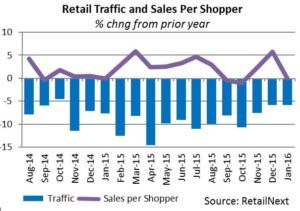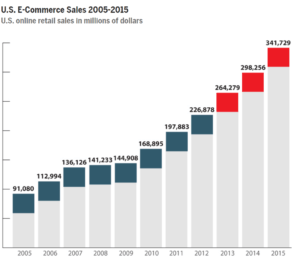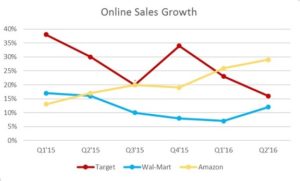Targeting a New Future

How is Target coping with the shift to e-commerce?
“Redefining Target will require a renewed emphasis on prioritization and innovation, and above all else, putting our guests first in everything we do.” [1] -Brian Cornell, Target Chairman and CEO, March 3rd 2015
Target’s core purpose is to “fulfill the needs and fuel the potential” of its millions of annual visitors, and over the past 20 years, Target has done that by delivering luxury products at an affordable price, wrapped in an excellent customer store experience. However, in the past decade, the dramatic rise of e-commerce, with over 250% growth in the past 10 years, combined with a steady decline in store traffic, which has been declining at a rate of 5-10% per month for the past 2 years, has transformed the retail landscape and pushed Target to rethink its business to ensure it continues to meet customer expectations.


Historically, Target has focused on delivering an upscale shopping experience at affordable prices using a strategy that relied upon design partnerships with famous designers, such as Philippe Starck and Michael Graves, and creative advertising campaigns [6]. Its operating model centered on the in-store experience, providing customers with a clean and well-maintained store, positive shopping atmosphere and shorter wait times at the check out counter. With the shift to e-commerce, Target has invested heavily in expanding its capabilities to operate in an omni-channel world, which has a significant shift in its operating model, but little has changed in its core customer promise. In 2015, Brian Cornell, Chairman and CEO of Target announced a plan to invest $2 billion a year on technology and supply chain projects starting in 2017 in order to achieve a goal of 40% online sales growth per year [1]. Target is specifically focusing on two things in the digital space:
- Becoming channel agnostic, curating a Target experience across stores, online and mobile. Guests who shop Target in stores and online generate three times the sales compared to those who shop at physical store locations alone. Target is pushing to enhance its technology, supply chain and inventory management to make it simple for customers to shop via all channels. [1]
- Strengthening data and analytics to deliver more personalized digital experiences, loyalty programs and promotional offers. This initiative will be executed in conjunction with an overall focus on creating a more guest-centric experience across the physical channel as well, tailoring by location, climate, demographics and other key customer characteristics. [1]
As part of this effort, Target has done a number of things including the launch of their “Cartwheel” app, which presents in-store discounts to customers via mobile device, and partnering with Instacart to provide faster deliveries for groceries and other daily essentials, and health and beauty items. Target has also attempted to link the in-store and online experience by placing iPads in stores and introducing Service Advisors, team members trained in exploring Target.com, among other tasks. These efforts contributed to an annual growth in digital channel sales of over 30% [3] in 2015, a rate that has slowed at the start of 2016.

- Utilize data analytics to more effectively utilize its brick and mortar stores as warehouse hubs. Target has nearly 1800 stores scattered across the United States, and these stores represent a significant opportunity to reduce delivery times for customers. Accurate demand planning can drive lower inventories and less space utilization, which will allow its stores to serve more customers at a better cost.
- Continue to experiment with new technologies to mimic the in-store experience online. For example, providing high resolution 3D imaging on the store’s website would allow customers to view or even virtually “try out” potential purchase items in their homes. Target could leverage these customer platforms to attract more customers into their stores and to the overall business.
- Innovate the store experience through layout, product mix and location. Target has already pushed in this area with its “CityTarget” stores and “LA25 initiative,” in which Target trials its top 50 in-store innovations and enhancements in 25 Los Angeles stores. [7]
All in all, Target is headed in the right direction with customer experience as its guiding star. Time will tell if these initiatives will be enough. (794)
[1] “Target Share Roadmap to Transform Business,” published March 3, 2015. Target Corporate. https://corporate.target.com/press/releases/2015/03/target-shares-roadmap-to-transform-business
[2] “Charts and Data,” Internet Retailer, accessed November 16th. https://www.internetretailer.com/trends/sales/us-e-commerce-sales-2005-2015/
[3] “2015 Target Annual Report.” https://corporate.target.com/annual-reports/2015
[4] Krystina Gustafson, “Target Sales, Earnings Top Wall Street Forecasts as Traffic Improves; Raised Guidance,” CNBC, November 15th, 2016. http://www.cnbc.com/2016/11/16/target-reports-third-quarter-2016-earnings.html
[5] Adam Levy, “How are Target and Wal-Mart Doing in the Battle Against Amazon,” The Motley Fool, August 20th, 2016. http://www.fool.com/investing/2016/08/20/how-are-target-and-wal-mart-doing-in-the-battle-ag.aspx
[7] Patrick Bartwise, Sean Meehan, “Bullseye: Target’s Cheap Chic Strategy,” excerpt from Simply Better: Winning and Keeping Customers by Delivering What Matters Most. http://hbswk.hbs.edu/archive/4319.html
[8] “Introducing LA25, Target’s New Innovation Initiative,” published September 16th 2015. Target Corporate. https://corporate.target.com/article/2015/09/la25-announcement



Great post, Duane! It’s a fascinating time for discount retailers as Amazon (and others) have completely transformed the industry, offering unprecedented convenience, ease, and price. It sounds like Target has launched some interesting initiatives to better connect with customers using digital tools. I’m particularly interested in your point about how Target is “mimicking” the in-store experience online and enabling customers to virtually “try-out” products. I’d love to hear more about how they’re doing this. Has it been successful? As I read your post, I was left wondering if Target is really doing enough to stay competitive. In the future, perhaps Target can better leverage strategic partnerships and acquisitions to boost the speed and scale of its digital transformation. I remember just a few months ago, Walmart spent $3B+ to acquire Jet.com, considered to be one of the most innovative e-commerce companies in the country. If Target is going to keep pace with Walmart and others, pursuing investments like this will likely become increasingly important.
Thanks for this post! As an avid Target shopper, it was interesting to learn about their digital transformation in the rise of ecommerce. It seems that most big-box retailers are executing the same general strategies: leveraging their stores as an online order distribution network, investing in their mobile app, and utilizing big data to personalize customer experiences.
I would challenge the causal insinuation of the statistic “Guests who shop Target in stores and online generate three times the sales compared to those who shop at physical store locations alone.” I don’t necessarily think that customers spend more simply because they have access to both physical and digital channels. It could also be the case that the customers who love Target the most engage in all of their channels, and therefore being one of Target’s best customers made them an omnichannel shopper – not necessarily that the omnichannel strategy made them one of Target’s best customers.